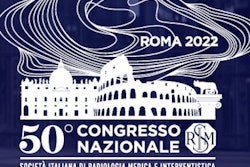
Italy's first nationwide audit of multidetector CT (MDCT) practice, which assessed dose exposures of 5,668 patients, can act as a reference for European optimization programs and as a starting point for updating diagnostic reference levels (DRLs), according to the authors.
They evaluated exposure levels for the most common CT protocols, including multiphase studies, where the highest doses were registered. Dose indices correlated with body mass index, voltage, rotation time, pitch, and tube current. Also, the high variability in CT protocols and comparison with other surveys suggests dose reduction could be achieved, noted Federica Palorini, a researcher at the Fisica Sanitaria Istituto Europeo di Oncologia in Milan, and colleagues.
"The use of radiology information systems, as well as structured reports and automatic tools for dose monitoring, may help in CT patient data collection, reducing operator work, and manual reporting errors. However, it is important to keep in mind that some patient data such as weight, height, or clinical indication are manually recorded before patient examination and can therefore include mistakes," they wrote in an article posted online by Insights into Imaging on 10 October.
Large-scale patient dose surveys remain important for evaluating dose exposure in clinical practice and should encourage radiologists and radiographers to optimize their CT protocols, they added. Furthermore, the variety of procedures, including multiple acquisitions on various anatomical regions or different indications, still imposes the need for careful data collection and a detailed analysis in order to compare homogeneous data.
The audit is part of a major project that started in 2010 and was sponsored by the Italian Society of Radiology (SIRM) in collaboration with the Italian Society of Medical Physics (AIFM). There was particular concern that the present Italian DRLs refer to the old European guidelines of 1999.
The group conducted a retrospective multicenter study and included 5,668 patients from 65 radiology departments who had undergone common CT protocols: head, chest, abdomen, chest-abdomen-pelvis (CAP), spine, and cardiac. They analyzed patient characteristics, CT parameters, volumetric CT dose index (CTDIvol), and dose length product (DLP) for each CT acquisition phase. Descriptive statistics were calculated, and a multiregression analysis was used to outline the main factors affecting exposure.
"We evaluated the magnitude of radiation dose to patients, in terms of CTDIvol and DLP, and the CT acquisition settings including the use of dose reduction systems. Particular attention was paid to multiphase examinations: we collected both the DLP, referring to a single acquisition (DLP), and the DLP of a complete patient examination (total DLP). The association of radiation dose with the different acquisitions and patient characteristics was also investigated," they wrote.
The 75th percentiles of CTDIvol (mGy) and DLP (mGy cm) for whole head were 69 mGy and 1,312 mGy cm, respectively; for chest, 15 mGy and 569 mGy cm; spine, 42 mGy and 888 mGy cm; cardiac, 7 mGy and 131 mGy cm for calcium score, and 61 mGy and 1,208 mGy cm for angiographic CT studies. High variability was present in the DLP of abdomen and CAP protocols, where multiphase examinations dominated (71% and 73% respectively): for abdomen, 18 mGy, with 555 and 920 mGy cm in abdomen and abdomen-pelvis acquisitions respectively; for CAP, 17 mGy, with 508, 850 and 1,200 mGy cm in abdomen, abdomen-pelvis and CAP acquisitions respectively.
The CT examinations were performed between January and November 2011. The 70 MDCT systems in the study represented 8% of the 871 systems estimated to be in use in Italy in 2009. The sampling rate was broadly appropriate (85% of requested), although the Northwest was over-represented and the other geographic domains were somewhat under-represented, especially for spine and cardiac protocols, because fewer centers perform these studies, the authors explained.
The 16- and 64-slice MDCTs accounted for most systems in the study: 26 (37%) and 34 (49%) respectively. Nearly all of the CT manufactures are represented, with GE Healthcare's machines being the most prevalent (43%). The patients included in the sample were almost equally divided between women and men: 2,647 (47%) and 3,044 (53%) respectively, with an average age of 64 ± 16 for both genders. The height and weight of the patients were retrospectively recovered for a subset of sample only (23% of all patients for weight and 29% for height). The researchers found the mean weight and height to be 68 ± 13 kg and 163 ± 7 cm for women and 77 ± 12 kg and 173 ± 8 cm for men, corresponding to an average BMI of 26 ± 8 kg/m2 for both genders.
"The recruitment for this survey may have been biased toward radiology departments interested in dose optimization," they stated. "The wide range of participating centers, however, appears representative of the national situation. In fact, we included large academic hospitals and small district hospitals with a diffuse regional distribution mainly from the National Health Service that actually perform the large majority of the MDCT examinations in Italy."
An all-inclusive patient survey would have been more precise, but would have been expensive and may have become obsolete before completion. Also, the registration of tube current modulation settings and beam collimation is not standardized between different CT manufacturers, so those parameters were not included in the statistical analysis. Finally, a dedicated analysis would have been useful to fully understand the implications of new dose reduction algorithms, the authors conceded.



















